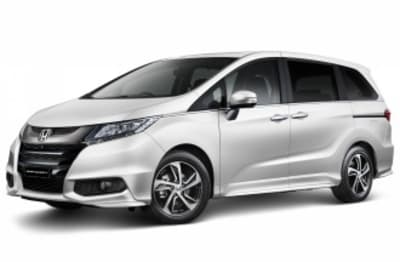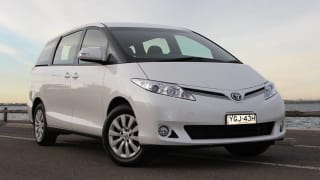Peter Anderson road tests and reviews the new Honda Odyssey VTi-L with specs, fuel consumption and verdict.
People movers. Remember them? When the second Tarago came out, it was almost like the monkeys gathering in awe around the obelisk in 2001: A Space Odyssey. Apologies for the terrible segué, but even in terms of the fickle car market, we got over them pretty quickly. The Honda Odyssey may not have apes gaping at it in wonder, but now in its fifth generation, it's hanging in there.
Its Wheels Car of the Year glory days might be behind it, but the Odyssey has kept alive its core principle - a people mover for people who don't want a people mover.
Price and features
There's a choice of two Odysseys - the eight seat $37,610 VTi and the car we had, the seven seat $46,040 VTi-L.
That's the real benefit of the Odyssey - it's more like a car, has little or nothing in common with a tradie's van.
For the extra outlay, you might lose a seat but you do get 17-inch alloys, a six-speaker stereo, three-zone climate control with vents all the way to the third row, rear window blinds, reversing camera, front and side cameras, keyless entry and start, electric and heated front seats, leather trim, sat nav, auto LED headlights, auto parking, power everything and woodgrain trim panels.
The six-speaker stereo is powered by Honda's 7.0-inch touchscreen software, which also has built-in sat nav rather than the cumbersome phone app required by the VTi (also seen on our long-term HR-V). The touchscreen is a snappy piece of hardware but the software itself is pretty ordinary and the processor seems slow. USB, bluetooth and HDMI connectivity are also included. CarPlay and Android Auto are not. Honda could do worse than to include them, as it has on the new Civic, to great applause.
In news that I hope will delight you as much as it did me, you can choose any one of the five available colours without having to pay any extra. Bargain.
Practicality
Well, there's little arguing over the space, is there? Contained within its 4.84m length, 1.82m of height and 1.69m width are seven seats and an ocean of space to fit them in (remember, the VTi has eight seats).
The VTi-L has seven seats because the middle row is made of up two captain's chairs. They move back and forward by an almost alarming amount and also slide side to side to open up a flat gangway to the third row. The middle seats, as the name suggests, are big and plush and even come with old-school Business Class leg rests that fold up from behind your calves. Number one son rather enjoyed the novelty although his 182cm frame overwhelmed the leg rest a little.
The rear seats can be folded out of the way to create a tall, wagon-like space, a process obviously benefitting from all Honda has learned from the work with the Jazz's magic seats. The two front seats are similarly luxurious but no legrests. Nanny state, eh?
Honda says the minimum available cargo space is 330 litres, which is average for a small hatchback like, say, a Civic. Fold away the third row and, at a guesstimate, you've easily got 1500 litres to play with, more if you push the middle row all the way forward.
Entry and exit are a breeze for people of most shapes and sizes, the VTi-L upping the ante by having powered sliding doors on both sides of the car (van is not the right word) which can be activated from the key fob or the driver's seat.
Front seat passengers get a pair of cupholders and a weird, retractable storage tray that took the skin off my shins when I'd forgotten I had it extended and went to walk through to the back seat. The tray is a good place for keys and phone, with the two-storey arrangement that helps organise your cables. As it's a Honda, there are plenty of other little pockets, slots and bins around the cabin, including in both sliding doors and at the rear seats. The back row goes without cupholders, though.
Design
After the previous generation, made famous by the snogging parents being caught by someone's elderly mother in the front seat, this Odyssey doesn't quite have the slinky appeal. Honda's current fondness for heavy-handed detailing has burdened the nose with a big chrome grille reminiscent of a Ford USA truck's bonce. The back end is better but the lights and reflectors are huge.
The profile is also more upright than the older car but with the attendant increase in cabin volume, not a terrible trade-off. A pity there isn't a way to hide the external guide rails for the doors, but again, in exchange for sliding rather than opening doors, we can live with them.
Inside isn't quite as imaginative as the HR-V or Civic, but the Odyssey is older than both of these cars and shows early signs of evolution. The space is carpeted with good quality mats but there's a distinct whiff of US-led styling in here. The dash is a model of clarity and is low to improve vision out of the massive, raked windscreen.
The screen is integrated into the dash and the funky touch-sensitive climate controls are only let down by low-rent digital watch LCD figures. The wood trim is inoffensive and lifts the ambience slightly, as does the moulded stitching in the dash plastics. The racecar-red Stop-Start button is hilarious.
The Japanese-built Odyssey is beautifully put together even if it isn't as beautiful to look at.
Engine and transmission
The Odyssey's 1.8 tonnes are pushed along by a 2.4-litre naturally aspirated four cylinder engine, producing 129kW and 225Nm. That torque figure is low but, with the aid of a continuously variable transmission (CVT), doesn't feel as weedy as it might.
It would be fascinating to see what happened if Honda fitted the Civic's new 1.5-litre turbo - it has strikingly similar numbers...
Fuel consumption
Honda claims a combined cycle average of 7.8L/100km on 91 RON unleaded, we got just over 10.0L/100km around town and some short highway bursts.
Driving
I could complain that the Odyssey sucks on a race track but a) I didn't take it to one because b) that would be stupid. When you're getting on two tonnes of tall people mover, it's churlish to criticise ultimate roadholding or how quickly it changes direction.
Taking into account its purpose and heft, it's not a bad car at all. It's clearly tuned to keep everyone happy and their lunches down, with a ride that is only challenged by the biggest and sharpest of speed bumps.
The focus on passenger comfort goes right down to the details, like a completely flat floor for easy access and climate controls for the back with vents above both the second and third rows. Passengers love this car because they're very well looked-after. Just dropping a couple of bench seats in a van doesn't really work anymore.
The driver has a pretty easy deal of it too. The engine pulls reasonably strongly and the Honda CVT once again proves itself the best of a pretty bad bunch by behaving like a normal automatic most of the time. The limited torque is wrung out of the engine by this transmission ensuring smooth progress even when loaded up. No, it won't keep up with a diesel or V6 Kia Carnival, but you won't have paid as much for the Odyssey in the first place.
On that point, the Odyssey is easier to manoeuvre owing to its tight external dimensions. That's the real benefit of the Odyssey - it's more like a car, has little or nothing in common with a tradie's van, which means much greater refinement, and it drives like a normal hatch. You always know you've got a postcode of space behind your back in a Carnival.
Safety
Standard safety kit includes six airbags, ABS, stability and traction controls, reverse cross traffic alert, and blind spot monitoring.
ANCAP awarded the Odyssey five stars in May 2014, the highest rating available.
Ownership
All Hondas come with a three-year/100,000km warranty with the option to extend to five years/140,000km if you're happy to cough up a few more bucks.
Fixed price servicing is known as 'Tailored Service' and runs for five years/100,000km. The 1000km service is a freebie but after that you'll pay between $267 and $305 for the next ten services, for a total of $2832 or an average spend of about $566 per year.
On top of that, you'll need to pay to replace various fluids and consumables, adding up to a further $988, meaning a bill of closer to $764 per year on average. The big ticket items are the fuel filter ($281 at 80,000km), new spark plugs at 100,000 ($173!) and CVT fluid replacements (every three years or 40,000km, I counted in two at $152 each).




















